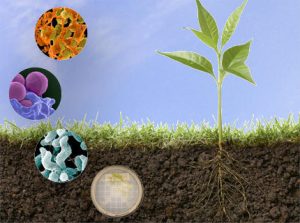
Source: https://dl.sciencesocieties.org/publications/sh/articles/56/5/sh2015-56-5-f
What if I told you that soil was not lifeless dirt, but home to an entire microbial ecosystem? Now, what if I told you these microbes were the key to improving soil quality and reducing the amount of carbon dioxide in the atmosphere? These are just a few of the innovations that spring from systems thinking. By thinking about soil as one living system in an interconnected web of systems, and not just a place where seeds go, it uncovers opportunities to improve human systems like the world food industry.
The farming industry has focused on producing the highest yield crops at the expense of the Earth’s delicate topsoil. Farmers pump the ground full of synthetic nitrogen to boost production, then strip leftover biomass to make way for the next crop. This leftover biomass, however, is a key part of replenishing the soil by imparting nutrients as it decays. Without it, soil becomes more dry and devoid of nutrients. This leaves it susceptible to being washed away during irrigation or blown away in strong winds. Over time, the land is no longer arable. But even when farmers leave this biomass, they find the soil is already so damaged that the biomanss just sits on top without breaking down. How can we keep the soil fertile and healthy?
It turns out, there’s more to soil than sand and clay. Tiny organisms live in the soil, eating up plant matter and producing carbon, resulting in rich soil. The carbon they produce is also stable, meaning it will remain sequestered in the soil without being released into the atmosphere. These microbes, however, are not thriving. They rely on the same elements all living things do—not just nitrogen, but phosphorus and sulfur along with hydrogen and oxygen. The organisms are getting nitrogen from fertilizer and enough hydrogen and oxygen from the air, but not enough phosphorus and sulfur to function normally. By treating soil with these nutrients as well, the microbes are able to flourish and break down plant matter into stable carbon. The result is rich, fertile soil and less carbon in the atmosphere.
There is still more work to be done to scale this system, but these startling results are evidence of the power of systems thinking. Without thinking of the soil as its own living system, arable land will continue to vanish. By implementing these and other holistic strategies, we have a chance at building sustainable human systems.
Source: http://grist.org/food/the-secret-to-richer-carbon-capturing-soil-treat-your-microbes-well/
